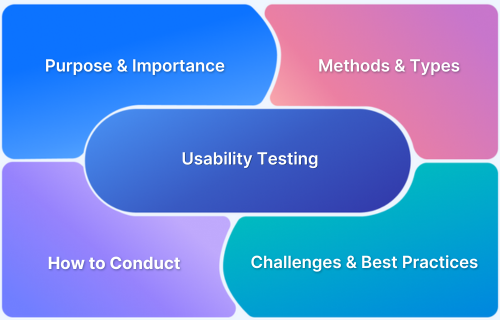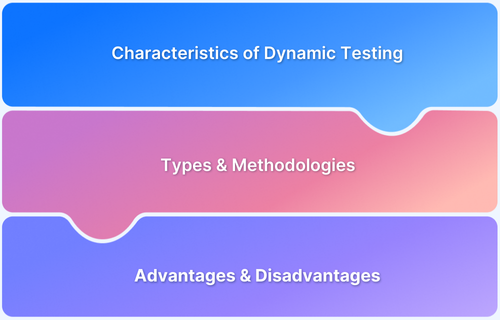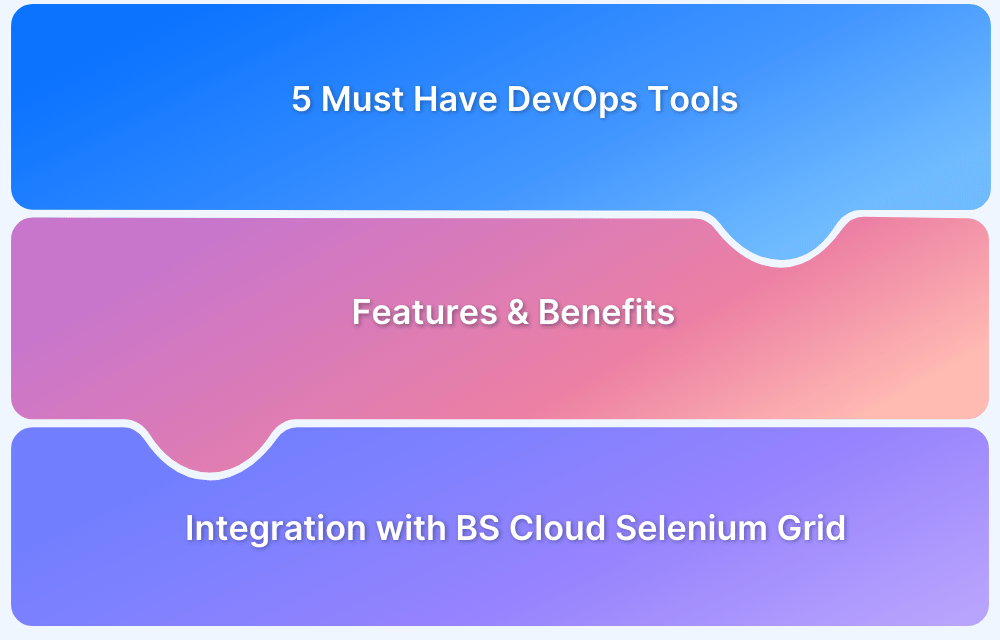Proof of Concept (POC) helps evaluate whether a chosen automation approach, framework, or tool can effectively meet the testing requirements before committing to full-scale implementation.
Overview
What is Proof of Concept (POC)?
A Proof of Concept (POC) is a decision-making process to prove that your proposed test automation tool works in the real world and is suitable for your organization. Proof of concept for the Test automation tool is needed when the organization or the team wants to adopt a new automation tool.
When to Perform a POC for a Test Automation Solution
- Evaluating New Tools or Frameworks
- Adopting Automation for the First Time
- Migrating from Legacy Tools
- Introducing Automation in a New Application
- Scaling Automation Across Teams
Top Tools for Automation Testing POC
- BrowserStack Automate
- Selenium
- Cypress
- Playwright
In this article, we will learn in detail about POC, its importance in automation testing and more.
What is Proof of Concept (POC) in Automation Testing?
The best way to choose the right framework is to perform POC for the test automation tool.
A Proof Of Concept, often abbreviated as POC, is a decision-making process to prove that your proposed test automation tool works in the real world and is suitable for your organization. Proof of concept for the Test automation tool is needed when the organization or the team wants to adopt a new automation tool. New Automation tools are usually needed when you want to switch from one tool to another(migration) or an organization wants to switch from manual testing to automation testing.
Why do we need the POC in Testing?
Here are the reasons why POC is important in testing:
- Feasibility Check: Makes sure that automation is technically possible with the selected tools and frameworks for the given application (web, mobile, API, etc.).
- Tool Evaluation: Compares tools to find the best fit based on project requirements, ease of use, integration support, and team skillset.
- Risk Reduction: Identifies challenges like tool limitations or integration issues before full-scale implementation.
- Cost and Time Efficiency: Avoids wasting time and resources by validating effectiveness before committing to large-scale automation.
- Stakeholder Confidence: Demonstrates value and ROI of automation with a working prototype, helping get buy-in from stakeholders or management.
- Framework Assessment: Tests framework design decisions like test structure, reporting, and CI integration in a small, controlled setting.
When to Perform a POC for a Test Automation Solution
Here are the situations when you should consider performing a POC:
1. Evaluating New Tools or Frameworks
When your team is considering a new automation tool (like Cypress, Playwright, Selenium, etc.), a POC helps test its capabilities in your environment.
Why: Not all tools work well with all applications (e.g., heavy DOM manipulation, non-standard UI components).
2. Adopting Automation for the First Time
If your team is new to automation, a POC helps assess if your application is automation-friendly and what kind of ROI you can expect.
Why: Not every test scenario may be worth automating. A POC helps identify quick wins.
3. Migrating from Legacy Tools
When moving from an outdated or unsupported tool, a POC ensures the new solution can meet current and future needs.
Why: It validates compatibility with your tech stack and helps compare performance or maintainability.
4. Introducing Automation in a New Application
If you’re working on a new web/mobile/API application, a POC can help choose the right approach early.
Why: Testing needs can vary across platforms; a one-size-fits-all solution may not work.
5. Scaling Automation Across Teams
When multiple teams need to collaborate on automation, a POC can test if a centralized framework or CI/CD integration works at scale.
Why: Prevents future roadblocks related to maintainability, parallel execution, and integration.
How to Perform POC for test Automation Tool?
To start POC for the test automation tool, you must consider the requirements and scope. It would be best to analyze why you need an automation tool, use cases, etc.
To do this, you must first define the scope, discuss the requirements, identify the tools that closely match your requirements, and then do a POC in testing.
Define the scope
Discuss with the product team about use cases. List down the more critical features of the product.
Discuss the Automation framework requirements
Discuss with stakeholders or higher-level management what they are looking for in the automation framework. Below are some basic examples of requirements (the tool requirement varies from organization to organization)
- Licensed or Open source
- Preferred programming language
- Supported features etc.
Get the List of all the tools
Once you get the automation tool requirement, start looking for tools that match your requirement.
Shortlist the tools
You cannot do POC for all the tools you have listed, so you need to shortlist some from the set of tools you got. Go through the online resources and analyze the tools—Shortlist the top and best tools among them.
When you shortlist, prepare a document answering the questions such as why you have shortlisted these tools, why other tools may not fit into shortlisting, etc.
Propose the POC Tool
You have the shortlisted tools; now you need to propose why you want to perform POC on this and how long this POC may take. Prepare a detailed document and share it with the management/stakeholder.
Perform POC for Automation Tools
Once you have got a ’go ahead’ from management or stakeholders, start your POC.
Factors to consider while performing Automation Tool POC:
- Prepare a set of test cases (minimum 10)
- Test cases complexities should be medium to high
- Test cases should also include critical features of your application
- Test cases should combine edge-case scenarios, negative scenarios, complicated scenarios, etc.
Once you have listed all the required test cases for POC in testing, start building your basic framework. Below are some examples of framework functionalities (this varies from organization to organization.)
- Testc ase reprint
- Basic CI/CD Integration
- Basic Page Object Pattern (if required)
- BDD Integration
- Types of Testing Support Mobile, Desktop, API, etc.
- Cloud-based testing support
Execute the Sample test cases and carefully note down the analysis.
Prepare a detailed POC (Analysis Report)
Document the entire process that was followed – right from identifying the scope to the reason why you shortlisted a particular tool. The documentation should be clear and concise. Some essential points you should mention are:
- What are the features that you considered and why?
- What are the test cases that you considered and why?
- What framework-level features were implemented, and how can you enhance them
- What are the limitations? And what is the workaround for those limitations?
- What is the learning effort involved?
- What is the maintenance effort in the future?
- How easy is it to migrate in case required?
Based on the POC you have done, the organization has to conclude.
There are two scenarios here
- The organization made you as sole decision-making person
- Organization asked for your opinion. However, you are not the sole decision-making person.
Evaluating Results in POC
Here are factors to be considered while evaluating results in POC:
- Success Criteria Fulfilled: Check if the POC met its intended goals like automating key test cases, integrating with CI/CD, or running within the expected timeframe.
- Execution Time: Compare how long automated tests take compared to Manual testing. Faster execution indicates higher efficiency.
- Test Stability: Evaluate the reliability of the tests. Frequent false positives or flaky tests signal issues with tool compatibility or timing.
- Test Coverage: Assess how many and which types of test scenarios were automated. More meaningful coverage means better value.
- Ease of Use: Consider how easy it was to set up the tool and write the tests. A shorter learning curve helps with quicker adoption.
- CI/CD Integration: Check if the tool integrated smoothly with your existing pipelines (like Jenkins, GitHub Actions, etc.).
- Maintenance Effort: See how easily tests could be updated when the application changed. Lower maintenance means better long-term scalability.
- Team Feedback: Gather input from testers and developers to make a meaningful evaluation.
- Support & Documentation: Confirm if there was enough guidance available, such as official documents, community forums, or vendor support.
- ROI Potential: Estimate the value regarding time saved, reduced manual effort, and risk mitigation. This helps justify the investment.
Based on the findings, decide whether to adopt, refine, or reject the automation solution.
Top Tools for Automation Testing POC
Here are the top tools you can use for Automation testing POC:
1. BrowserStack Automate
BrowserStack is a cloud-based testing platform that allows teams to run automated tests across a wide range of real browsers and devices (3500+). It is an ideal option for cross-browser and cross-device automation at scale.
Why use for POC:
- No infrastructure setup needed. Tests can be run on cloud devices
- Supports Selenium, Cypress, Playwright, and more
- Easily integrates with CI/CD tools like Jenkins and GitHub Actions
- Offers visual logs, video playback, and debugging features
2. Selenium
Selenium is one of the most popular open-source frameworks for web automation testing. It supports multiple programming languages (Java, Python, C#, etc.) and browsers.
Why use for POC:
- Ideal for validating cross-browser testing needs
- Strong community support
- Works well in CI/CD pipelines
- Flexible and highly customizable
3. Cypress
Cypress is a modern JavaScript-based end-to-end testing framework focused on speed, simplicity, and developer experience.
Why use for POC:
- Real-time test execution and debugging
- Built-in wait and retry mechanisms
- Quick setup for modern web apps
- Strong for front-end unit and integration testing
4. Playwright
Playwright, developed by Microsoft, is a powerful and fast-growing tool that supports cross-browser automation (Chrome, Firefox, Safari) from a single API.
Why use for POC:
- Supports modern web app testing with auto-wait features
- Cross-browser and headless support by default
- Great for multi-tab, multi-page, and mobile emulation tests
Template for POC in Automation Testing
Here is a sample template for POC in automation testing:
1. POC Objective
Briefly explain the purpose of the POC.
E.g., “To evaluate Cypress for automating end-to-end tests on our React-based web application.”
2. Tools Being Evaluated
| Tool Name | Reason for Selection |
|---|---|
| BrowserStack | Cloud-based testing across real devices |
| Cypress | Fast, developer-friendly for modern apps |
| Playwright | Modern tool with multi-browser support |
3. Scope of POC
Define what will be tested during the POC.
- Key test scenarios: Login, Form Submission, Search Functionality, Checkout Flow
- Platform: Web (Chrome, Firefox)
- Integration: GitHub Actions CI/CD
- Team Involvement: 1 QA, 1 Dev
4. Success Criteria
| Criteria | Expected Outcome |
|---|---|
| Test Coverage | 5–10 critical user flows |
| Execution Time | < 5 minutes per test suite |
| Flakiness | < 10% false positives |
| CI/CD Integration | Fully integrated with GitHub Actions |
| Ease of Maintenance | Scripts easily maintainable |
| Team Feedback | Positive feedback on usability |
5. POC Results
| Metric | Observation |
| Setup Time | Completed in 1 day |
| Tests Automated | 8 critical workflows |
| Test Execution Time | 4 minutes (vs. 40 minutes manually) |
| Tests Automated | 8 critical workflows |
| Flaky Tests | 1 test flaked due to async load |
| Integration Status | CI pipeline triggered and passed |
| Tool Usability | Easy to use; readable syntax |
6. Challenges Faced
Mention any limitations or blockers like:
- Dynamic element locators required additional handling
- Limited mobile emulation in one tool
- Slight learning curve for first-time users
7. Recommendation
State your conclusion clearly.
Recommended Tool: Cypress with BrowserStack integration
Reason: Fast execution, intuitive syntax, great CI/CD support, and cloud testing scalability.
Best Practices for POC in Automation Testing
Here are the best practices to be followed for executing POC in automation testing:
- Define Clear Objectives: Set specific goals, such as validating tool compatibility, measuring execution time, or assessing ease of use.
- Identify Key Scenarios: For quick evaluation, choose a small set of critical and repeatable test cases (such as login, checkout, or form validation).
- Set Success Criteria: Establish measurable benchmarks like max execution time, test stability, CI integration, and ease of maintenance.
- Limit Scope and Duration: Keep the POC focused and time-bound (e.g., 1–2 weeks) to avoid resource drain and maintain momentum.
- Use Realistic Test Data: Run tests using data that reflects actual user behavior to ensure meaningful evaluation results.
- Evaluate Across Environments: Test on multiple browsers, devices, or OS versions. You can use tools like BrowserStack and run tests on real devices, browsers, or OS versions on the cloud instead of setting up a physical infrastructure.
Conclusion
By starting with a well-defined PoC, teams can identify potential challenges early, optimize test coverage, and ensure a smoother transition to robust, maintainable automation frameworks.
Leveraging reliable platforms like BrowserStack can significantly streamline this process by providing access to a wide range of real devices and browsers, enabling comprehensive testing in a scalable and efficient manner.






